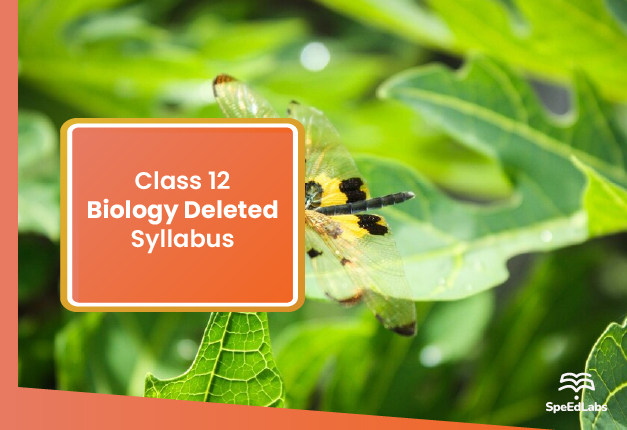The Central Board of Secondary Education has released the Biology deleted Syllabus class 12. Students can refer and download the deleted syllabus of Biology Class 12 2022-23 from the SpeEdLabs website. Also, they can access the Biology class 12 Deleted Syllabus from the official website, cbseacademic.nic.in.
Biology Deleted Syllabus Class 12: CBSE deleted Biology Syllabus class 12 2022-2023 which was recently released by the Central Board Of Secondary Education is quite different from that of the previous CBSE Class 12 Syllabus. Otherwise, you will not see any changes to the syllabus of 2021-22 for Classes 9, 10, 11 and 12. Students should begin preparing immediately for the new academic session so they won’t be burdened at the last minute.
The CBSE syllabus for Class 12 Biology in 2022 contains all the units, chapters, and topics for the theory exam and the practical exam. Class 12 biology deleted syllabus contains the marks allotted for each unit. Students will find the CBSE Deleted portion of Biology class 12 2022-23 helpful in both academics and competitive examinations. For more information about the biology deleted syllabus Class 12 in 2022, read the entire article.
Deleted Syllabus for Biology Class 12 2022-2023
The CBSE Class 12 Biology Syllabus 2022-23 consists of 5 units. There will be 70 marks for the theory papers and 30 marks for the practical exams.
| Unit Number | Unit Name | Marks |
| VI | Reproduction | 16 |
| VII | Genetics and Evolution | 20 |
| VIII | Biology and Human Welfare | 12 |
| IX | Biotechnology and its Applications | 12 |
| X | Ecology and Environment | 10 |
| Total | 70 |
- Unit VI: Reproduction
| Chapter Name | Topics |
| Sexual Reproduction in Flowering Plants | Flower structure; development of male and female gametophytes; pollination – types, agencies and examples; out breeding devices; pollen-pistil interaction; double fertilization; post fertilization events – development of endosperm and embryo, development of seed and formation of fruit; special modes- apomixis, parthenocarpy, polyembryony; Significance of seed dispersal and fruit formation. |
| Human Reproduction | Male and female reproductive systems; microscopic anatomy of testis and ovary; gametogenesis -spermatogenesis and oogenesis; menstrual cycle; fertilisation, embryo development upto blastocyst formation, implantation; pregnancy and placenta formation (elementary idea); parturition (elementary idea); lactation (elementary idea). |
| Reproductive Health | Need for reproductive health and prevention of Sexually Transmitted Diseases (STDs); birth control – need and methods, contraception and medical termination of pregnancy (MTP); amniocentesis; infertility and assisted reproductive technologies – IVF, ZIFT, GIFT (elementary idea for general awareness). |
- Unit VII: Genetics and Evolution
| Chapter Name | Topics |
| Principles of Inheritance and Variation | Heredity and Variation: Mendelian inheritance; deviations from Mendelism – incomplete dominance, co-dominance, multiple alleles and inheritance of blood groups, pleiotropy; elementary idea of polygenic inheritance; chromosome theory of inheritance; chromosomes and genes; Sex determination – in humans, birds and honey bee; linkage and crossing over; sex linked inheritance – haemophilia, colour blindness; Mendelian disorders in humans – thalassemia; chromosomal disorders in humans; Down’s syndrome, Turner’s and Klinefelter’s syndromes. |
| Molecular Basis of Inheritance | Morphology of different parts of flowering plants: root, stem, leaf, inflorescence, flower, fruit and seed. Description of family Solanaceae. |
| Evolution | Origin of life; biological evolution and evidences for biological evolution (palaeontology, comparative anatomy, embryology and molecular evidences); Darwin’s contribution, modern synthetic theory of evolution; mechanism of evolution – variation (mutation and recombination) and natural selection with examples, types of natural selection; Gene flow and genetic drift; Hardy – Weinberg’s principle; adaptive radiation; human evolution. |
- Unit VIII: Biology and Human Welfare
| Chapter Name | Topics |
| Human Health and Diseases | Pathogens; parasites causing human diseases (malaria, dengue, chikungunya, filariasis, ascariasis, typhoid, pneumonia, common cold, amoebiasis, ringworm) and their control; Basic concepts of immunology – vaccines; cancer, HIV and AIDS; Adolescence – drug and alcohol abuse. |
| Microbes in Human Welfare | Microbes in food processing, industrial production, sewage treatment, energy generation and microbes as biocontrol agents and bio-fertilizers. Antibiotics; production and judicious use. |
- Unit IX: Biotechnology and its Applications
| Chapter Name | Topics |
| Biotechnology – Principles and Processes | Genetic Engineering (Recombinant DNA Technology). |
| Biotechnology and its Applications | Application of biotechnology in health and agriculture: Human insulin and vaccine production stem cell technology, gene therapy; genetically modified organisms – BT crops; transgenic animals; biosafety issues, biopiracy and patents. |
- Unit X: Ecology and Environment
| Chapter Name | Topics |
| Organisms and Populations | Population interactions- mutualism, competition, predation, parasitism; population attributes – growth, birth rate and death rate, age distribution. (Topics excluded: Organism and its Environment, Major Abiotic Factors, Responses to Abiotic Factors, Adaptations) |
| Ecosystem | Ecosystems: Patterns, components; productivity and decomposition; energy flow; pyramids of number, biomass, and energy (Topics excluded: Ecological Succession and Nutrient Cycles) |
| Biodiversity and its Conservation | Biodiversity-Concept, patterns, importance; loss of biodiversity; biodiversity conservation; hotspots, endangered organisms, extinction, Red Data Book, Sacred Groves, biosphere reserves, national parks, wildlife, sanctuaries and Ramsar sites. |
Biology1 Class 12 Practical Deleted Syllabus 2022-2023
- A) List of Experiments
- Study the presence of suspended particulate matter in air at two widely different sites.
- Study the plant population density by quadrat method.
- Study the plant population frequency by quadrat method.
- B) Study/Observer of the following (spotting)
- Pollen germination on stigma through a permanent slide or scanning electron micrograph.
- Mendelian inheritance using seeds of different colour/sizes of any plant.
- Controlled pollination – emasculation, tagging and bagging.
Also Read –
Also published on Medium.
